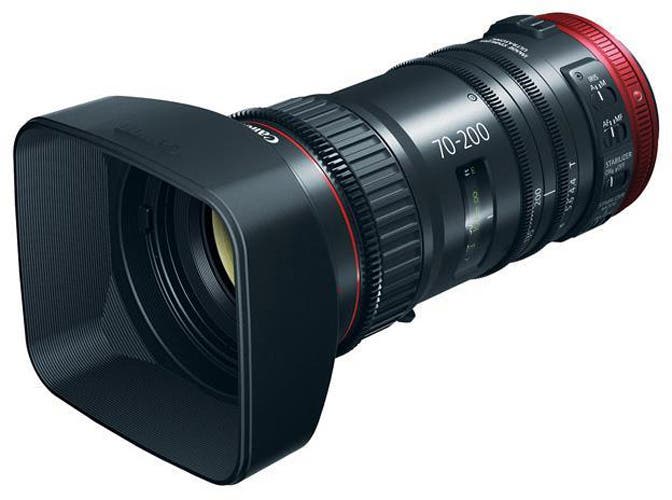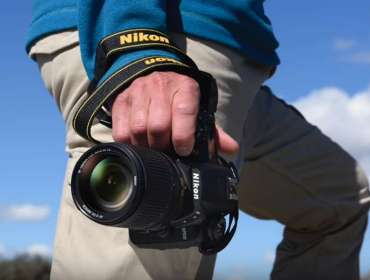Now, it’s a family: Canon today announced its second Compact-Servo Lens, a 70-200mm model with the same attributes as the Canon Compact-Servo 18-80mm T4.4 EF Lens, which was introduced last year. The same size and weight of its wide-tele zoom sibling, the 70-200mm T4.4 EF is designed for cinematographers moving up from Canon EF lenses and DSLRs to dedicated Canon Cine cameras such as the Canon EOS C100. The new lens offers a similar range of functions as its sibling model, making it well-suited for video applications such as documentary, cinema, news gathering, wedding and other video production.

The Canon Compact-Servo 70-200mm T4.4 EF lens promises 4K optical performance in a compact, 7.2-inch long lens that weighs 2.76 pounds. It features full external servo control and an integrated servo drive unit that is compatible with broadcast industry-standard lens controllers, including the Canon standard broadcast lens controllers ZSD-300D and FPD-400D. An optional ZSG-C10 Zoom Servo Grip mounts to the lens for hand-held operation.
The lens boasts three levels of Image Stabilization, a 9-blade iris for rounded aperture that produces pleasing, natural-looking out-of-focus specular highlights that appear circular. The smooth-rotating focus ring turns 130 degrees. Unlike the 18-80mm T4.4, the 70-200mm lens is compatible with Canon’s EF 1.4x and 2x tele extenders, making it a practical, compact solution for capturing sports, nature, and wildlife footage.
The lens offers a commonly-used focal range that is optimized for high-level 4K performance. Here’s a deeper dive into its impressive feature set.
Parfocal Operation – Precise Focus Through the Entire Zoom Range
The 70–200mm T4.4 EF lens is parfocal in both manual and autofocus modes—it maintains consistent focus even as you change the focal length. The lens employs a special compensating lens group that moves to maintain precise focus while a separate lens group performs the zooming action. Maintaining focus while changing focal length allows the lens to be used in video production where zooming while recording is required.
Consistent Brightness Throughout the Entire Zoom Range
The 70–200mm T4.4 EF lens maintains a wide aperture of T4.4 (F4.0) throughout their zoom range. This allows zooming while at maximum aperture without any dimming of the image.
High Level 4K Optical Performance
Canon claims 4K optical performance from the 70–200mm T4.4 EF lens; this produces a significantly sharper image than 2K/HD. The various advanced design strategies used help to ensure over 4K resolution at picture center and a careful control of falloff of image sharpness at picture extremities.
The excellent contrast range associated with High Dynamic Range (HDR) imaging helps ensure both deep black reproduction and the excellent handling of scene specular highlights. HDR image capture significantly enhances both the contrast and the richness of colors in a scene, but it also poses a potential challenge in exacerbating the visibility of any lens chromatic aberrations. The 70–200mm T4.4 EF lens was designed to help minimize such aberrations.
Color Consistency
Canon’s color science has become highly refined over generations of lens designs, paying the closest attention to a pleasing skin tone reproduction. The 70–200mm T4.4 EF lens can be used interchangeably with other Canon Cinema lenses during the same production since both have the same warm, cine-look color characteristics — making it easier to maintain consistent color when multiple lenses are used.
Iris Mechanism for Motion Picture
The 70–200mm T4.4 EF lens can smoothly adjust between open and closed for precise exposure control and live in-shot changes. The 9-blade iris creates a rounded aperture so out-of-focus highlights appear circular. An odd number of iris blades also helps create a less distracting flare. The iris on the lens can also be completely closed, which is useful when adjusting black balance.
Continuous Iris Control Capability with Iris Ring
A Cinema lens requires an iris that can be smoothly adjusted between wide open and closed. Continuous adjustment allows not only for precise exposure control, but also smooth adjustment live in shot while recording. This can be useful to help compensate for change in exposure due to spotty clouds or moving between indoor and outdoor light levels within a shot.
9-Blade Iris
More iris blades create a rounder aperture, resulting in out-of-focus highlights that appear more circular. An odd number of iris blades means that there will be a larger number of small radiating points on a flare, helping to prevent distracting artifact.
Iris Closing
The aperture on the 70–200mm T4.4 EF lens can close completely, allowing no light to pass through. This is useful in black balancing a camera.
Auto Iris Available
The auto exposure system in the 70–200mm T4.4 EF lens capitalizes on Canon’s Electromagnetic Diaphragm (EMD) technology that has been highly refined over many years in the EF lens series. This technology integrates the lens iris assembly and a miniature stepping motor in a single unit. Electronic pulses from the camera controls the motor to map numerous steps across the full range of the iris mechanism. This AE control loop is fast and silent. An AE Shift mode allows a small manual override for fine adjustments to exposure.
Flange Back Adjustment
A flange back adjustment mechanism is built in. It lets you adjust on-site, which helps to provide even greater optical performance among various cameras.
Servo Zoom Control
The integrated servo drive provides electronic control over the zoom. The control is electromechanical, rotating the actual geared rings on the lens housing via servo motors. These motors can also be disengaged, allowing for full manual control. The zoom servo can be remotely controlled or operated using a rocker switch on the side of the lens.
Power Provided via Camera Mount
On select Cinema EOS cameras, the EF lens mounts electrical contacts provide the necessary power to operate the servos on the 70–200mmT4.4 EF lens. This helps eliminates cabling and possible mounting issues. The lens can also be powered remotely through an accessory power port.
Compatible with Broadcast Style Servo Lens Controllers
The 70–200mm T4.4 EF lens’s Servo Control can be operated remotely for tripod or other non-handheld use. Canon’s FPD-400D Digital Focus Servo Demand for Canon Lens Control Kits can be used for remote focus control and the ZSD-300D Digital Zoom Servo Demand for digital ENG/EFP lenses used for remote zoom control. For use in studio configurations, an optional Zacuto Z-CNYC Y-cable can be used to connect zoom and focus controllers to each lens. This configuration allows for simultaneous zoom and focus operation with Compact-Servo lenses.
Supports a Wide Range of Optional Accessories
The 70–200mm T4.4 EF lens is built to be compact and fully compatible with a variety of professional lens accessories. The front diameter is 84mm for mattebox mounting, with a removable sunshade included. The front ring’s inner diameter is threaded for use with 77mm screw-in filters. An integrated support foot can be used to stabilize the lens on standard camera bracketry, and the zoom, focus and iris rings are geared for use with follow focus and other traditional mechanical and electronic controllers.
Enhanced Compatibility with our Cinema EOS Cameras
Canon has designed the COMPACT-SERVO 70–200mm T4.4 EF lens specifically to work with compatible Cinema EOS cameras, resulting in a complete kit that adds enhanced functionality. Integrated autofocus, smooth image stabilization, connected control and metadata information as well as lateral chromatic aberration correction are all available when using the lens on compatible Cinema EOS cameras.
Pricing and ordering information will be announced.






